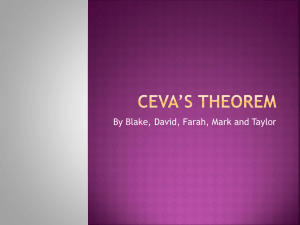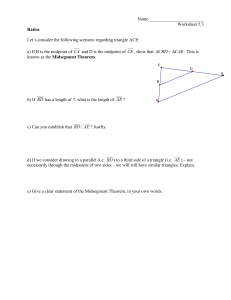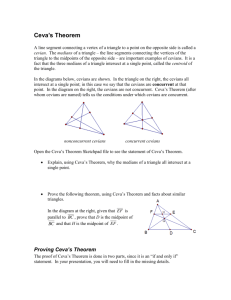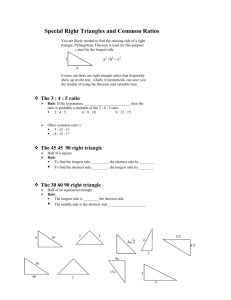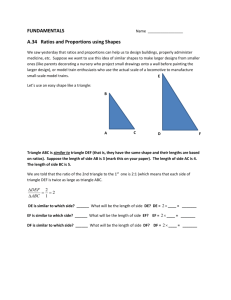Ceva`s Theorem
advertisement
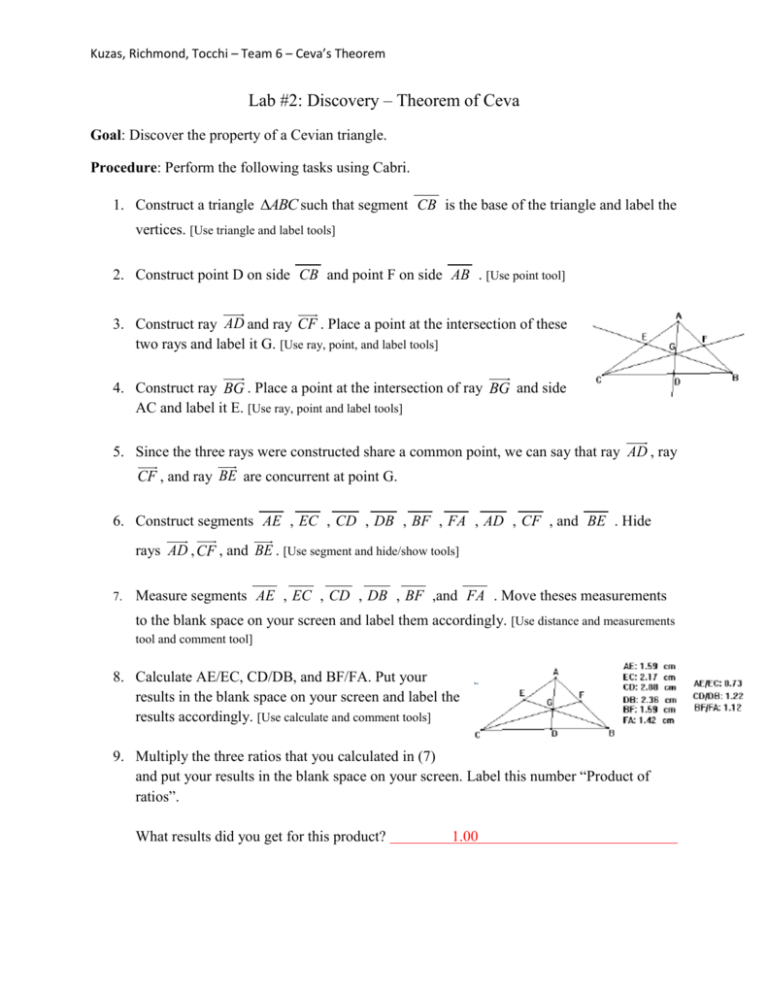
Kuzas, Richmond, Tocchi – Team 6 – Ceva’s Theorem Lab #2: Discovery – Theorem of Ceva Goal: Discover the property of a Cevian triangle. Procedure: Perform the following tasks using Cabri. 1. Construct a triangle ABC such that segment CB is the base of the triangle and label the vertices. [Use triangle and label tools] 2. Construct point D on side CB and point F on side AB . [Use point tool] 3. Construct ray AD and ray CF . Place a point at the intersection of these two rays and label it G. [Use ray, point, and label tools] 4. Construct ray BG . Place a point at the intersection of ray BG and side AC and label it E. [Use ray, point and label tools] 5. Since the three rays were constructed share a common point, we can say that ray AD , ray CF , and ray BE are concurrent at point G. 6. Construct segments AE , EC , CD , DB , BF , FA , AD , CF , and BE . Hide rays AD , CF , and BE . [Use segment and hide/show tools] 7. Measure segments AE , EC , CD , DB , BF ,and FA . Move theses measurements to the blank space on your screen and label them accordingly. [Use distance and measurements tool and comment tool] 8. Calculate AE/EC, CD/DB, and BF/FA. Put your results in the blank space on your screen and label the results accordingly. [Use calculate and comment tools] 9. Multiply the three ratios that you calculated in (7) and put your results in the blank space on your screen. Label this number “Product of ratios”. What results did you get for this product? 1.00 Kuzas, Richmond, Tocchi – Team 6 – Ceva’s Theorem 10. Grab point D and move it along segment CB . [Use pointer tool] What happens to the length of the segments? The length of segments change What about the ratios you calculated? The ratios change as well Does the “Product of Ratios” change? No, it stays the same 11. Construct segment CK so that it is not concurrent with ray AD and ray BE at points G and K is a point on segment AB (different from point F). [Use segment tool] 12. Determine the distance from point A to point K and point K to point B. Label these values AK and KB and place them in the blank spaces on your screen. [Use distance and length, and comment tools] 13. Calculate BK/KA and put this value in the blank space on your screen. Use this value in place of BF/FA and calculate the “Product of ratios” (multiply AE/EC, CD/DB, and BK/KA together). Label this value with “Product of ratios using K.” [Use calculate and comment tools] What value do you get for the “Product of ratios using K”? 0.46 14. Grab point K and drag it along segment AB . [Use the pointer tool] What happens to the measurement of the segments and the “Product of ratios using K”? As I move K closer to F, the product gets closer to 1. The closer I move it to A, the larger the ratio and the closer I move it to B, the smaller the ratio. Kuzas, Richmond, Tocchi – Team 6 – Ceva’s Theorem When does the “Product of ratios using K equal to 1”? When K is the same as F 15. What can be said about the “Product of ratios,” if the segment that joins the vertices and the point on the opposite side of the triangle are concurrent? If the point that joins the vertices is concurrent, the Product of Ratios will be exactly 1.00. Does this product remain the same if the three segments are not concurrent? No 16. Are the three segments that join the three points on the sides of the triangle to the vertices concurrent if the “Product of ratios” is not equal to 1? No 17. Summarize your findings in this lab and try to develop a theorem based on your answers to #13 and #14. Given a ABC and points D, E, and F on sides CB , AC , and AB respectively. The lines AD , BE , and CF are concurrent if and only if the product of the ratios of each side of the triangle is exactly 1. 18. Kuzas, Richmond, Tocchi – Team 6 – Ceva’s Theorem Extension: 1. Open a new screen in Cabri and construct ABC using the segment tool. 2. Find the midpoints of the segments AB , BC ,and CA and label these points X, Y, and Z respectively. 3. Use the segment tool to connect each midpoint with the vertex that is opposite to it in the triangle. 4. What do you notice about the three segments that are constructed in (3)? The three segments meet at exactly one point. 5. Using the information that you discovered in this lab, what can you say about the product of the ratios of the sides of the triangle given the information from (4)? The product of the ratios is exactly 1. Which makes sense because we used the midpoints of the line and thus the ratio of one half of the line to the other one half of the line is 1 and 1x1x1=1 6. Calculate the product of the ratios of the sides of ABC to support your conclusion. Kuzas, Richmond, Tocchi – Team 6 – Ceva’s Theorem Lab #3: Discovery – Theorem of Ceva Goal: Discover trigonometric form of Ceva’s Theorem. Procedure: Perform the following tasks using Cabri. 1. Construct so that the base is BC and label the vertices. [Use triangle and label tools] 2. Construct the three rays AD , BE , and CF so that they are concurrent at point G just as constructed in Lab #2. Label all points of intersection with appropriate letters. [Use ray, label, and point tools] 3. Construct segments AD , CF , and BE . Use the hide/show tool to hide rays AD , BE , and CF . [Use segment and hide/show tools] 4. Measure ABE , CBE , BCF , ACF , CAD , and BAD . Move the measurements off to the side in the white space of your screen and label them with the appropriate labels. [Use angle and comment tools] 5. Calculate sin( ABE )/sin( CBE ), sin( BCF )/sin( ACF ), and sin( CAD )/sin( BAD ). Place these calculations in the blank space on your screen and label them with the appropriate labels. [Use calculate and comment tools] 6. Multiply the three ratios that you calculated in (5) together and put them in the white space under the three ratios. Label the value with “Product of ratios.” [Use calculate and comment tools] What is the value of your “Product of ratios”? 1.00 7. Grab point D and move it along the segment BC . What do you notice about the measurement of the angles? They change What about the ratios that were calculated? They change Does the “Product of ratios” change? No 8. Using the information that was collected in Lab #2 and the new information that was discovered in this lab, can you state the trigonometric form of Ceva’s Theorem? Ceva’s theorem is also true for the sine of each angle ratios. I am curious to see if this works out with the cosine and tangent functions as well. Kuzas, Richmond, Tocchi – Team 6 – Ceva’s Theorem
